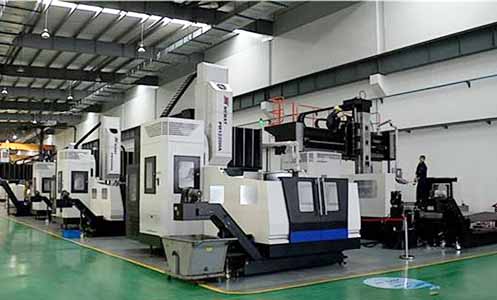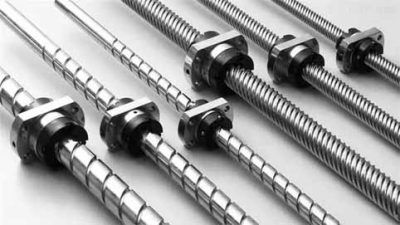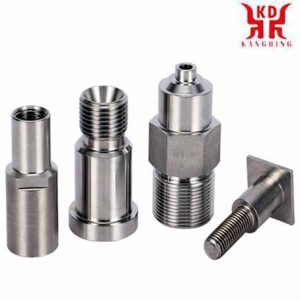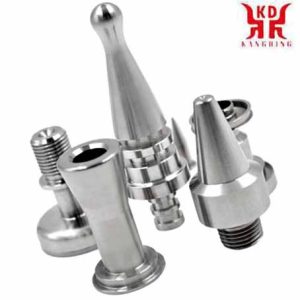CNC旋盤とは? CNC旋盤の旋削設定方法?
数値制御旋盤または CNC 旋盤とは、英数字データを使用するコンピューター ソフトウェアを使用して回転部品を機械加工するために使用される旋盤タイプの工作機械を指します。, デカルト X に従う, Y軸. 大量かつ正確に生産するために使用されます, 制御を組み込んだコンピューターが作品の実行を担当するため.
CNC 旋盤は、パラレル旋盤などのさまざまな種類の旋盤で通常行われるすべての作業を行うことができます。, コピーする, 回転する, 自動および垂直型も. 収益性は、加工される部品の種類と、連続して加工する必要がある部品の数によって異なります。.

CNC旋盤
数値制御
数値制御の分野における最初の開発は、アメリカの発明家ジョン・Tによって行われました。. パーソンズ氏と従業員のフランク・L氏. 盗まれた, 1940年代に. 数値制御 (CN) 工作機械の自動化システムです。, 文字や記号が使われている. 実行するタスクが変更された場合, 指導プログラムが変更される.
これらのプログラム用に確立された文字は DIN によって管理されています 66024 そして 66025 標準. 一部のキャラクターは、:
N – ブロックまたはシーケンス番号に対応します. 手紙のあと, プログラムするブロックの数が配置されます. ブロックの数は次の範囲内でなければなりません 1 そして 999.
機能している
の “バツ” そして “Z” 軸は交互に同時に移動可能, 部品の形状に応じて円錐または球面の加工が行われます。.
工具は、ヘッドに固定された工具ホルダーに配置され、最大で 20 選択したプログラムに従って回転するさまざまなツールホルダー, 複雑な部品の実現を容易にする.
加工プログラムでは, ワークヘッド回転速度, 縦方向および横方向のキャリッジの前進量と部品の実行座標をパラメータとして入力できます。. この機械は従来の旋盤よりもはるかに高い切削速度と送り速度で動作します。, そのため、材料疲労を軽減するために超硬金属またはセラミック工具が使用されます。.

研削丸ネジ付きボールネジ
General architecture of a CNC lathe
The characteristics of CNC lathes compared to a normal universal lathe are the following:
Motor and main head
This motor limits the real power of the machine and is what causes the rotating movement of the parts. Normally, current CNC lathes are equipped with a direct current motor, which acts directly on the spindle with a transmission by pulleys interposed between the location of the motor and the spindle, being unnecessary any type of transmission by gears.
These DC motors provide an almost infinite range of rotation speeds from zero to a maximum determined by the characteristics of the motor, which is programmable with the execution program of each part. Many engines incorporate two speed ranges, one for slow speeds and the other for fast speeds, in order to obtain the most favorable torque. The spindle has at its end the adaptation for the corresponding claw plates and a hole to be able to work with a bar.
The characteristics of the motor and main spindle of a CNC lathe can be the following:
Main spindle bore diameter: 100 んん
Main spindle nose: DIN 55027 No. 8 / Camclock No. 8
Morse cone No. 2
Speed range: 2
Variable spindle speed: I: 0-564 rpm II: 564-2000 回転数
Motor power: 15 kW
Movable bench and trolleys
In order to facilitate the rapid movement of the longitudinal and transverse carriages, the guides on which they slide are tempered and ground with a hardness of the order of 450 HB. These guides have an automated permanent greasing system.
The spindles of the carriages are made of hardened and ground balls ensuring great precision in the movements, これらのスピンドルはボールの再循環原理によって動作します。, これにより、エンドレス スクリューがそれぞれのキャリッジに接続されます。. エンドレススクリューが回転すると, キャリッジはベッドのガイドを通って縦方向に移動します. 回転方向を変える際の遊びがなく、抵抗が少ないネジです。. キャリッジと障害物との衝突による損傷を避けるために, アセンブリを切断して前進力を停止するクラッチが組み込まれています。.
各車両には、低回転での高出力と高トルクを特徴とするサーボ モーターまたはエンコーダー モーターなどの独立したモーターが搭載されています。. これらのモーターは従来の AC モーターと同様に動作します。, ただしエンコーダが接続されている場合. The encoder controls the exact revolutions given by the motor and brakes at the exact point that marks the programmed position of the tool.
一方で, the structure of the bed determines the maximum dimensions of the pieces that can be machined. Example of the specifications of the bed of a CNC lathe:
Height between points: 375 んん
Diameter admitted on bed: 760 んん
Diameter over longitudinal carriage 675
Diameter admitted on cross slide. 470 んん
Z, X axis working feed. 0-10000 んん / 分
Rapid movements Z, X axes 15/10 メートル / 分
Longitudinal thrust force 9050 N
Transverse thrust force 9050 N

Fasteners turned on CNC lathes
Fasteners turned on CNC lathes
Trolley positioning adjustment
Despite the quality of the elements that intervene in the mobility of the longitudinal and transversal carriages, there is no total guarantee of being able to achieve the position of the tools in the programmed position.
起こり得る位置決め誤差を修正するために、2 つの電子システムがあります。, そのうちの1つは直接的で、もう1つは間接的です. 直接位置調整システムでは、各ベンチガイドにある測定定規を使用します。, キャリッジの位置を正確に測定する光学式リーダーが機能する場所. 既存の偏差を CPU に転送 (中央処理装置) 正しい位置が得られるまで自動的に再プログラムされます。.
ツールホルダー
CNC 旋盤は、6 ~ 20 個の異なるツールを配置できるツール ホルダーとしてドラムを使用します。, 旋盤のサイズにもよりますが, またはその複雑さ. 工具交換は加工プログラムによって制御されます, そして変化するたびに, キャリッジは、適切な工具の回転と選択が行われる位置に戻り、加工サイクルを継続します。. 部品の加工が終わったら, キャリッジが作業エリアから退避する最初の位置に戻るため、問題なく部品を交換できます。. ツールホルダードラム, リボルバーとして知られる, 回転させるサーボモーターが組み込まれています, リボルバーを連動させる油圧または空圧システム, したがって、通常は次の範囲の精度が得られます。 0.5 そして 1 ミクロンミリメートル. 工具は、プログラムによって示された寸法に従って、旋盤の外部のアクセサリで適切な座標に調整する必要があります。. ほとんどの場合, 交換可能な超硬インサートを使用, which means that when the insert needs to be replaced, it is not necessary to remove the tool holder from its housing.
TOOL SETTER
This accessory allows us to facilitate the setting of the tools to be used in machining. Tool setting probes are easily installed on CNC machining centers and turning centers, allowing automated operation with the following benefits:
Significant time savings with reduced machine downtime
Accurate measurement of tool length and diameter
Automatic calculation and correction of tool compensation
Elimination of manual configuration errors
Accessories and peripherals
Machine accessories are known as those equipments that, as part of it, are acquired from an external supplier, because they are universally applicable for that type of machine. 例えば, a car battery is an accessory to it.
All machines that have built-in CNC operation require a series of accessories that in the case of a lathe are specified in the following:
CPU (Process Control Unit)
Dynamic Solid and Path Graphics
Profile editor
Input peripherals
Output peripherals

Stainless steel parts turned by CNC lathes
Stainless steel parts turned by CNC lathes
UCP (中央処理装置)
主な記事: Central processing unit
The CPU or CPU is the calculation brain of the machine, thanks to the microprocessor it incorporates. The computing power of the machine is determined by the installed microprocessor. Any of the CPUs on the market can be installed on each machine, 例えば: FAGOR, FANUC, SIEMENS, 等. The normal thing is that the client chooses the characteristics of the machine he wants and then chooses the CPU that best suits him for performance, 価格, service, 等.
The main functions entrusted to the PCU is to develop the command and control orders that the machine must have in accordance with the machining program that the programmer has established. such as calculating the exact position that the tools must have throughout the work process, by controlling the displacement of the corresponding longitudinal and transverse carriages. You must also control the technological factors of machining, that is the spindle revolutions and the work and rapid travel feeds as well as the tool change.
一方で, the CPU integrates the different memories of the system, which can be EPROM, ROM, RAM and BUFFER, which serve to store the programs and act as a hard disk of any computer.
The most significant and important input peripheral is the keyboard that is installed on the machine’s control panel, from where you can make corrections and modifications to the initial program, even develop an individual machining program. There are many types of input peripherals with greater or lesser complexity, which if they have to be built is resistant to aggressive environments such as those found in workshops.
The most important output peripheral is the monitor, which is where we are informed of the machining execution process and we can see all the values of each sequence. We can also control the manual movement of the trolleys and other moving parts of the machine.
Sequence number N
シーケンスとは、マシンに一度に与えることができる矛盾のない命令のセットを指します。. これらは文字 N で識別されます, そして最大まで 9999 通常の旋盤で連続オーダーが可能. プログラムがそれほど長くない場合, から番号を付けることができます 10 に 10, 予期せぬ補完的な注文を導入する必要がある場合に備えて, N10になります, N20, N30, 等. あるいは、, N10, N11, N20, 等.
準備機能G
数字を伴った文字 G の下には、旋盤が作業に適切かつ必要なタスクを実行できるようにするさまざまな機能がグループ化されています。.
準備機能には基本的に 5 つのタイプがあります:
モビリティ機能.
技術的機能.
変換関数.
特殊加工機能.
モーダル関数.
1- モビリティ機能 最も重要なモビリティ機能は次のとおりです。:
G00. 高速スクロール. Indicates the fastest possible movement of the tool carriage, from the reference point to the point where each tool starts work. Special care must be taken in the use of this function since the trajectory is not controlled by the user but rather the lathe acts based solely on the maximum travel speed. You never mechanize with it. It only acts at the beginning of the program, each time there is a tool change, and at the end of the program when returning to the reference point.
G01. Linear interpolation. Indicates that the tool is moving at the programmed work feedrate, allowing classic turning and facing operations as well as cone machining.
G02 Circular interpolation to the right (clockwise) It is used when it is necessary to machine spherical or radial areas with controlled speed.
G03. Circular interpolation to the left (counterclockwise). It is used when it is necessary to machine empty spherical areas, or left-hand radii.
There are other G mobility functions, less important and depending on the equipment that is installed in the machine.
2- Technological functions The technological functions are those that refer to the way of programming the spindle speed and the work advance. The spindle rotation speed can be programmed at the desired revolutions per minute, for which function G97 will be preceded, or it can be programmed to rotate at a constant cutting speed in m / 分. In this case it is indicated with function G96. The same happens with the work feedrate, if you want to program the feedrate in mm / rev, the G95 function is prepended and if you want to work in mm / min the G94 function is prepended.
3- Conversion functions The most important function of this group is the one that corresponds to the zero offset to locate the part zero that is carried out by means of the G59 function. There are also functions if the dimension is in inches or millimeters. Although the one that is going to be used normally has already been preset. Another case of conversion is if it is programmed with absolute dimensions or incremental dimensions.
4- 特殊加工機能. The most popular of these functions is the one corresponding to a threading cycle represented by function G33. Other functions of this type are facing, 掘削, たたく, リーミング, 等.
5- モーダル関数. In CNC programs, there are functions that, once programmed, remain active until a contrary function is programmed, or the program is terminated. These functions are called modal functions. 必要な数の機能をブロック内にプログラムできます, 互いに矛盾しない限り. 例えば, 関数 G00 と G01 をブロック内にプログラムすることはできません.
従来のCNC旋盤と比較したCNC旋盤のメリット・デメリット
アドバンテージ:
機械加工の精度を高めることができます。.
より複雑な部品の加工が可能になります.
ある部品の加工から別の部品への加工を簡単に変更できます.
オペレーターのミスが減少します.
CNC旋盤も安くなってきています.
加工時間の短縮.
デメリットとしては以下のようなものが挙げられます:
最初の部品を加工する前にプログラムを実行する必要がある.
工具や付属品のコストが高い, これは高額な投資を意味します.
コストが高いため、機械の占有面積が大きくて便利.

CNC旋盤で加工した真鍮部品
CNC旋盤で加工した真鍮部品
切りくず形成
The lathe has evolved so much that it is no longer just a matter of removing material at high speed, but the parameters that make up the process have to be closely controlled to ensure the final results of economy, quality and precision.
The way to treat the chip becomes a complex process, where all the technological components of machining intervene, so that it can have the size and shape that does not disturb the work process. Failure to do so would rapidly build up masses of long, stringy chips in the machining area, forming tangled and uncontrollable skeins.
The shape that the chip takes is mainly due to the material being cut and can be ductile as well as brittle and brittle.
The advance with which one works and the depth of the pass are quite responsible for the shape of the chip, and when it cannot be controlled with these variables, it is necessary to resort to choosing the tool that incorporates an effective chip breaker. 16 greater efficiency than a normal lathe is faster
Dry and coolant machining
Today dry turning is completely viable and is used in many applications. There is a recent trend to carry out dry machining whenever the quality of the tool allows it. A higher cut-off temperature zone can be a positive factor in many cases.
However dry machining is not suitable for all applications, especially for drilling, tapping and boring to ensure chip evacuation.
Operations, 材料, 部品, quality requirements, and machinery need to be carefully evaluated to identify the benefits of removing the refrigerant supply.
Technological fundamentals of turning
In turning there are six key parameters:
Due to their operating mechanisms, CNC lathes allow machining conditions to be adjusted to the maximum and therefore achieve the best possible turning time.
切断速度 (Vc). It is defined as the linear speed in the periphery of the area that is being machined. Your choice is determined by the material of the tool, the type of material of the part and the characteristics of the machine. A high cutting speed allows machining in less time but accelerates tool wear. The cutting speed is expressed in meters / minute.
Part rotation speed (N). Usually expressed in revolutions per minute. It is calculated from the cutting speed and the largest diameter of the pass being machined.
Advance (F). Defined as the penetration speed of the tool in the material. In turning it is usually expressed in mm / rev. しかし, in order to calculate the turning time, it is necessary to calculate the feedrate in mm / min for each pass.
Depth of pass. It is the radial distance that a tool covers in its working phase. It depends on the characteristics of the piece and the power of the lathe.
Machine power. It is expressed in kW, and it is what limits the general machining conditions, when it is not limited by other factors.
Turning time (T). It is the time it takes for all the tools to perform the machining without taking into account other issues such as possible control stops or the time to put and remove the part from the head, which can vary depending on each part and machine. It is calculated based on adding the partial times of each tool.
 English
English العربية
العربية 中文(漢字)
中文(漢字) Čeština
Čeština Dansk
Dansk Nederlands
Nederlands Suomi
Suomi Français
Français Deutsch
Deutsch Italiano
Italiano 日本語
日本語 ಕನ್ನಡ
ಕನ್ನಡ 한국어
한국어 Português
Português Русский
Русский Slovenčina
Slovenčina Español
Español Svenska
Svenska Türkçe
Türkçe

